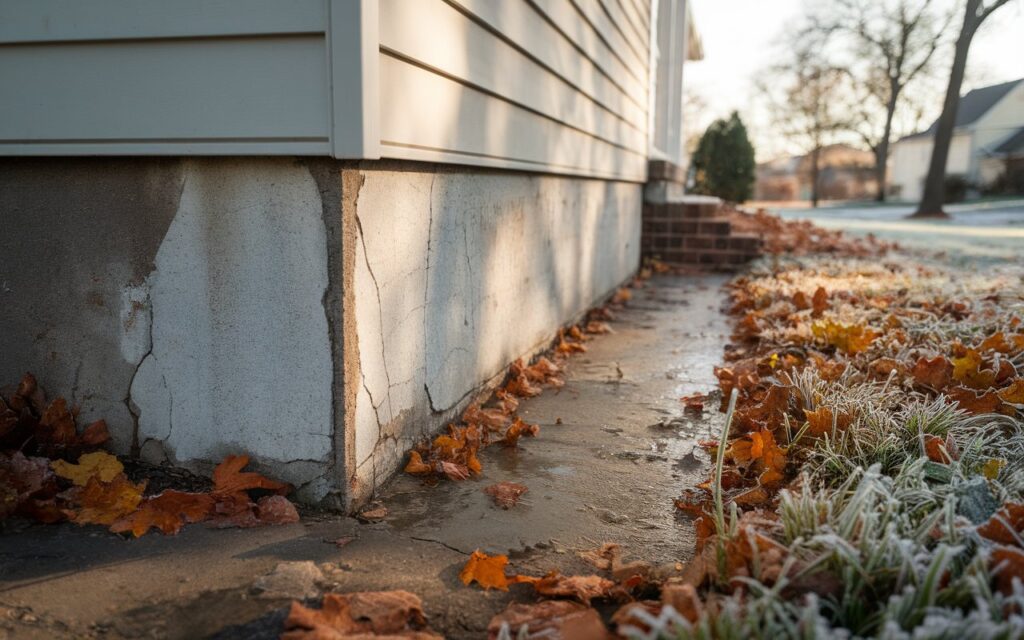Your home’s foundation is constantly exposed to environmental conditions that can impact its stability. Seasonal changes, including temperature fluctuations, rain, and soil shifts, play a major role in determining the longevity of a foundation.
Understanding how these factors affect your home can help prevent costly repairs and ensure long-term structural integrity.
The Impact of Temperature Swings
One of the biggest threats to a home’s foundation is extreme temperature changes. As the seasons shift, the soil expands and contracts, placing stress on the foundation.
- Winter Freezing and Thawing: During winter, freezing temperatures cause moisture in the soil to expand. This expansion creates pressure against the foundation, leading to cracks and structural movement. When temperatures rise, the thawing process causes the soil to contract, further destabilizing the foundation.
- Summer Dry Spells: In contrast, hot and dry summer conditions can cause soil shrinkage. Without sufficient moisture, the soil loses its ability to support the foundation properly, leading to settlement and cracks in walls or floors.
Homeowners often don’t notice these changes until visible damage appears. That’s why taking preventive action is key to avoiding expensive repairs. In cases where shifting has already compromised structural integrity, professional foundation crack repair can help restore stability and prevent further deterioration.
How Rain and Moisture Affect Stability
Water is a foundation’s worst enemy when it’s not properly managed. Different seasons bring varying levels of precipitation, which can either help maintain balance or contribute to serious foundation damage.
- Spring Showers and Heavy Rainfall: During spring, frequent rainfall saturates the soil around the foundation. Poor drainage can lead to water pooling near the base of a home, increasing hydrostatic pressure. This pressure forces water into cracks and can cause basement leaks or wall bowing.
- Flooding and Erosion: In areas prone to flooding, excessive water erodes soil layers, leaving voids beneath the foundation. This leads to uneven settling and, in severe cases, foundation failure.
Maintaining proper drainage through downspouts, grading, and French drains can help mitigate these risks. However, if moisture has already led to bowing walls or structural shifts, professional bowing repair may be necessary to reinforce weakened areas.
The Effect of Soil Movement on Foundation Strength
Soil type plays a critical role in how a foundation reacts to seasonal changes. Certain soils, like expansive clay, are particularly vulnerable to moisture variations.
- Expanding and Contracting Clay Soil: Clay-heavy soil swells when wet and shrinks when dry. This constant movement exerts pressure on the foundation, leading to cracks and misalignment of doors and windows.
- Loose, Sandy Soil: On the other hand, loose soils tend to erode easily when exposed to excessive water. Without proper compaction, sandy soil can cause a foundation to sink or shift over time.
Homeowners should assess their soil type and take appropriate measures to manage its moisture levels year-round. Installing foundation piers or other reinforcement methods can prevent excessive movement and protect the structural integrity of a home.
Seasonal Maintenance Tips to Prevent Foundation Issues
While seasonal changes can’t be avoided, homeowners can take proactive steps to minimize their impact on a foundation. Regular maintenance and inspections can go a long way in preventing costly repairs.
Manage Moisture Levels Around the Foundation
Keeping soil moisture balanced is essential for preventing both excessive expansion and contraction.
- During dry months, use soaker hoses to keep the soil from drying out too much.
- Ensure proper grading around the foundation to direct water away from the home.
- Install and maintain gutters to prevent water from pooling near the foundation.
Inspect for Cracks and Shifts Regularly
Small cracks can quickly turn into major structural problems if left unaddressed.
- Check basement walls, floors, and exterior concrete for new or expanding cracks.
- Pay attention to any doors or windows that suddenly become difficult to open or close.
- If cracks widen or bowing occurs, consider consulting a professional for repair before the damage worsens.
Address Drainage Problems Before Rainy Seasons
Proper drainage is one of the most effective ways to prevent foundation movement and water-related issues.
- Keep gutters clean and free of debris to ensure proper water flow.
- Extend downspouts away from the foundation to prevent pooling water.
- If your yard has poor drainage, installing a French drain can help redirect excess moisture.
Reinforce and Repair Foundation Issues Promptly
If you already see signs of foundation damage, acting quickly can prevent the need for more extensive repairs.
- Bowing or leaning walls may require reinforcement using carbon fiber straps or wall anchors.
- Cracks wider than 1/8 inch should be professionally evaluated and sealed to prevent water intrusion.
- Signs of settling may indicate the need for underpinning to stabilize the foundation.
Why Preventive Action Matters
Foundation damage tends to worsen over time, often leading to costly repairs. What may start as a small crack can escalate into major structural failure if left unchecked. By understanding how different seasons impact the foundation and taking action early, homeowners can preserve the integrity of their property.
Additionally, maintaining a strong foundation adds value to a home, making it more attractive to potential buyers. Buyers are often hesitant to invest in a property with visible structural issues, which can affect resale value and marketability.
Protecting Your Home Year-Round
Understanding how seasonal changes impact your foundation allows you to take proactive steps to protect your home. Temperature shifts, moisture levels, and soil movement all contribute to foundation stress, but regular maintenance can minimize their effects.
By managing moisture levels, inspecting for damage, and ensuring proper drainage, homeowners can prevent costly repairs. For homes already showing signs of structural instability, professional intervention ensures that minor issues don’t turn into major problems.
A stable foundation is the key to a secure home, and taking preventive measures today can save thousands in repairs down the road.

